Bryan L. Programmable controllers. Theory and implementation
Подождите немного. Документ загружается.

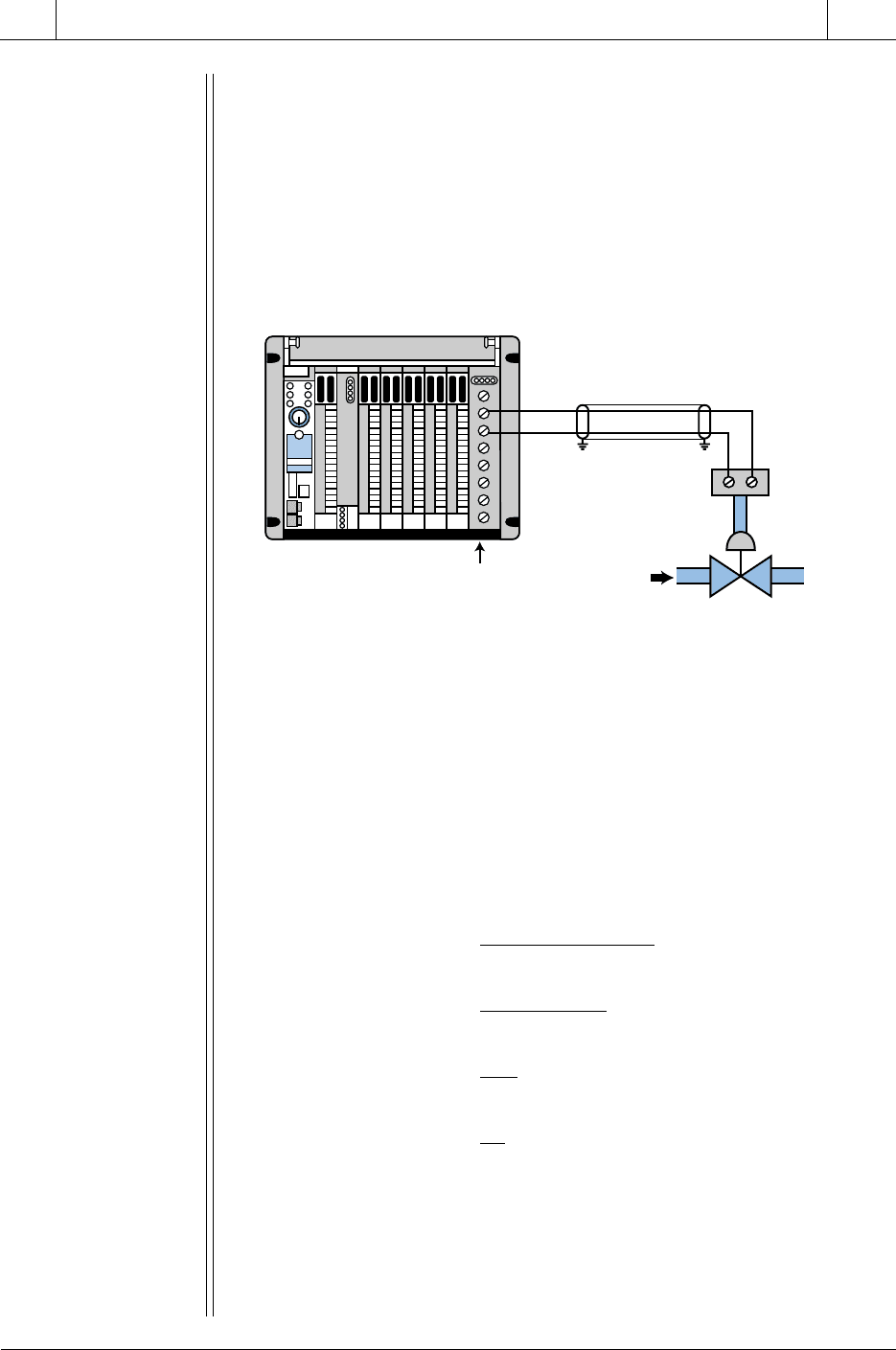
619
CHAPTER
14
Process Responses
and Transfer Functions
Industrial Text & Video Company 1-800-752-8398
www.industrialtext.com
SECTION
4
PLC Process
Applications
Figure 14-12. Process regulated by an I/P converter.
Analog
Output
Module
Steam
I/P Converter
To Reactor
Tank
EXAMPLE 14-2
The PLC system shown in Figure 14-12 has an analog output module
that sends a 0–10 VDC signal to an electric-to-pneumatic (I/P) con-
verter. The I/P converter controls a steam valve that regulates the
process to a set point of 140°C. The range of the controller output is
from 0 to 4095 counts, which provides a range of 20 to 220°C in steam
temperature control. The process variable has a value of 130°C. Find
the percentage of controller output as a function of voltage.
S
OLUTION
Figure 14-13 illustrates the relationship between the control variable
output and the controllable range of temperature. Since the relation-
ship between the controller output and the temperature is linear, the
equation of the control variable as a function of voltage is repre-
sented by:
CV
VV
TCV
CV T
T
T
T
volt
max min
max min
volt
Temp Temp
V V
CC
=
−
−
−
=
−
°− °
−
=
−
=
−
=()0
10 0
220 20
1
10
200
1
20
1
where
T
is the given value of the temperature and
CV
volt
is the output
of the controller in voltage. Note that this equation takes the form of
the equation of a line,
Y
=
mX
+
b
(see Appendix E). At a temperature
of 140°C, then, the controller output in voltage would be:

620
SECTION
4
PLC Process
Applications
Industrial Text & Video Company 1-800-752-8398
www.industrialtext.com
CHAPTER
14
Process Responses
and Transfer Functions
Figure 14-14. Minimum temperature output of 20°C corresponding to a 1 V
control variable output.
Figure 14-13. Relationship between control variable output and temperature range.
CV
volt
volts
=
−
=
140
20
1
6
So, the control variable in voltage as a percentage of total output
would be:
CV
CV CV
CV CV
%
.%
=
−
−
=
−
−
==
actual min
max min
6V 0V
10 V 0 V
060 60
If the minimum temperature output of 20°C corresponded to a con-
troller output of 1 volt instead of 0 volts, the percentage output would
be different because the value of the control variable (
CV
actual
) would
change, thus changing the percentage result (see Figure 14-14). A
temperature of 140°C would require a 6.4 volt output, which as a
percentage of the range would become:
0 counts 0 V
6.4 V
1 V
4095 counts 10 V
CV
20°C
SP
= 140°C 220°C
Temp
0 counts 0 V
6 V
4095 counts 10 V
CV
20°C
SP
= 140° 220°C
CV
actual
Temp
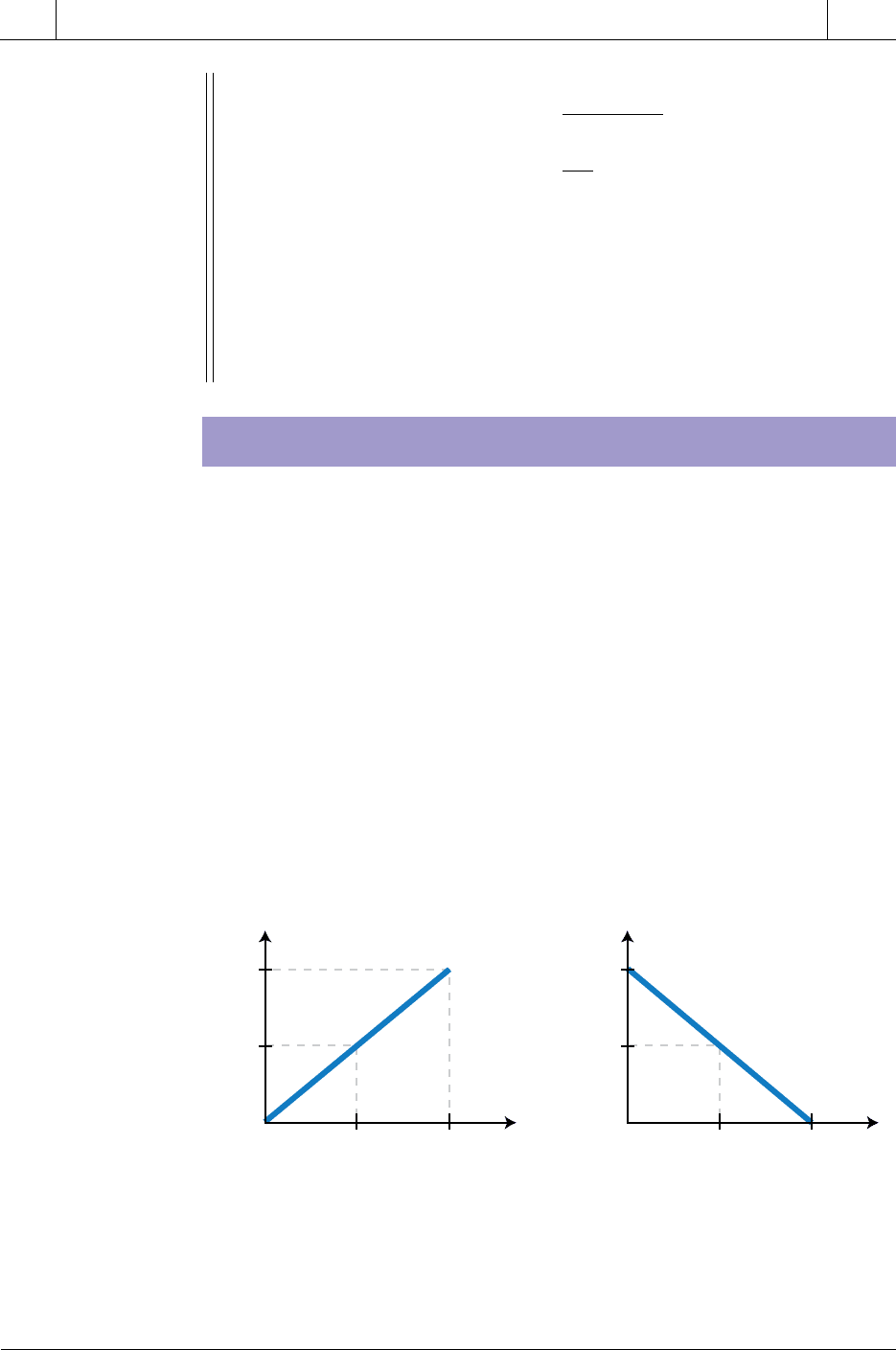
621
CHAPTER
14
Process Responses
and Transfer Functions
Industrial Text & Video Company 1-800-752-8398
www.industrialtext.com
SECTION
4
PLC Process
Applications
CV
%
.
.
.%
=
=
==
64
64
10
064 64
V – 0 V
10 V – 0 V
Having a minimum control output value that is greater than zero is
common in many process control systems, because most systems
require that the control element be constantly on to regulate the
process variable. Note, however, that the range of the control variable
is still from 0 to 10 V.
Figure 14-15. Direct and reverse action in process control.
0%
100%
50%
CV
E
SP PV
max
PV
min
E
= 0%
E
= +%
E
= –%
As percentage of error
increases
,
the control variable
increases
0%
100%
50%
CV
E
SP PV
max
PV
min
E
= 0%
E
= +%
E
= –%
As percentage of error
increases
,
the control variable
decreases
Direct Acting Reverse Acting
ERROR AND THE CONTROL VARIABLE
The control variable can affect the error in two ways, as illustrated in Figure
14-15. If the error becomes more positive as the control variable increases,
the action of the controller is called direct acting. On the other hand, if the
error becomes more positive as the control variable decreases, the action of
the controller is called reverse acting. Table 14-1 illustrates the relationship
between error and direct- and reverse-acting controllers. The error values
refer to the error as a percentage of the process variable range, meaning that
a positive error corresponds to a process variable that is greater than the set
point and a negative error corresponds to one that is less than the set point.
Note that the equation E = SP – PV yields error values that will have a sign
that is opposite of those just described. Therefore, the correct way to identify
the type of controller action (direct or reverse) is through the error computed
as a percentage of the full range. Chapter 15 discusses reverse- and direct-
acting controller modes in more detail.
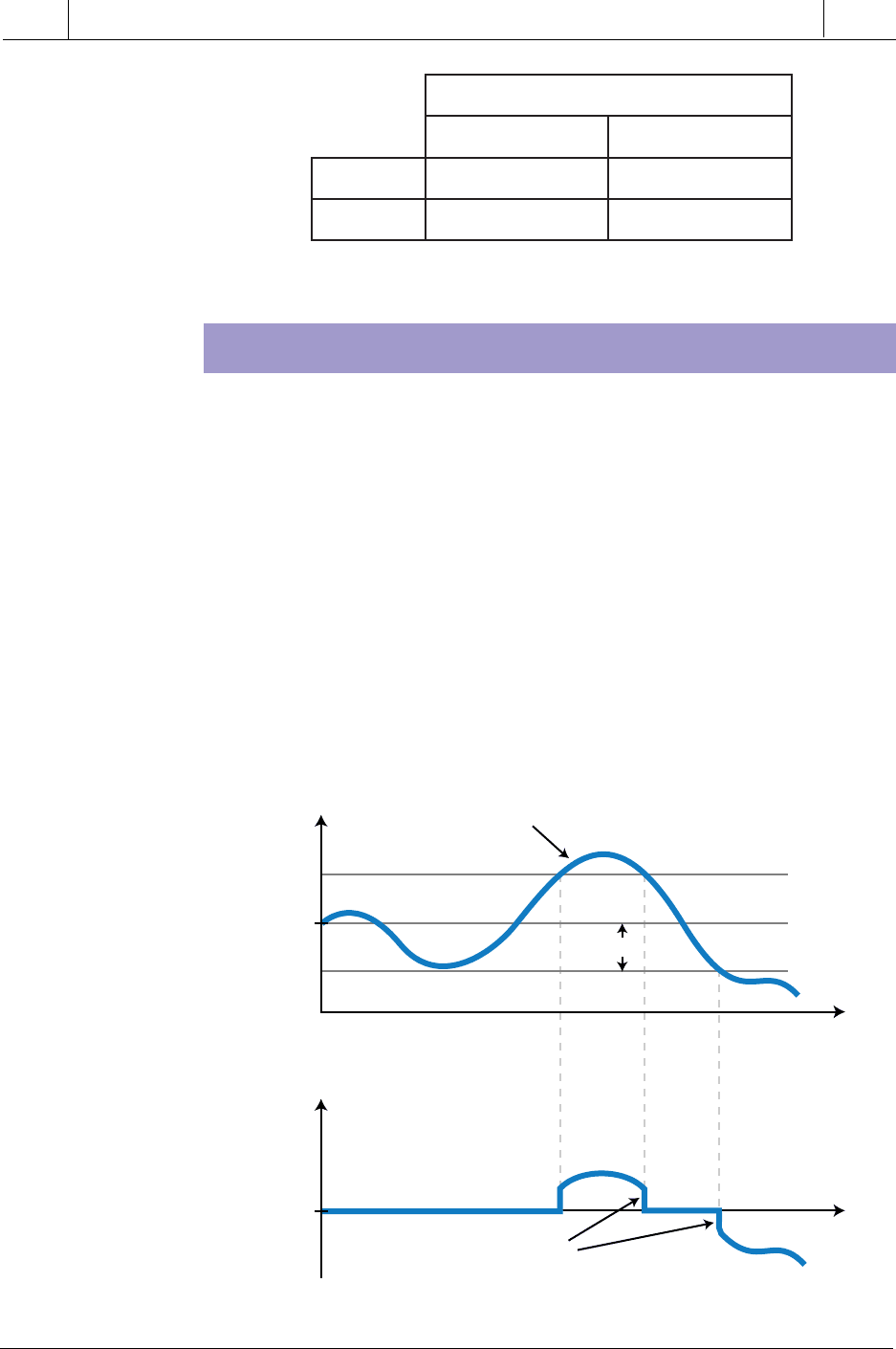
622
SECTION
4
PLC Process
Applications
Industrial Text & Video Company 1-800-752-8398
www.industrialtext.com
CHAPTER
14
Process Responses
and Transfer Functions
lortnoCelbairaV
gnitcAtceriDgnitcAesreveR
rorrE
rorrE
↑
↑
↑
↓
↓
↓
Table 14-1. Relationship between error and the control variable in direct- and reverse-
acting controllers.
Figure 14-16. Error deadband.
SP
–
DB
SP
SP
+
DB
PV
0
+
–
t
Error
DB
DB
Process
Variable
Error resumes as
soon as
PV
> (
SP
+
DB
)
or
PV
< (
SP
–
DB
)
ERROR DEADBAND
The purpose of a process control system is to keep the error value as close to
zero as possible. However, all systems have an allowable fluctuation in
error, meaning that the error can vary from zero by a certain amount without
hampering the final product. Figure 14-16 illustrates this fluctuation allow-
ance, which is called the error deadband. Within the deadband, the control-
ler treats the error as if it were zero, meaning that it will not make any
corrective actions to the control variable. If the value of the error deviates
from zero by more than the deadband, the controller will initiate a correction
by changing its output (CV). The error deadband is a user-specified value,
which the PLC stores in one of its registers.
Most PLCs that offer process control loop manipulation software have
upper and lower limit alarms, which engage when the process variable
deviates from the error deadband. An error will trigger these alarms, as shown
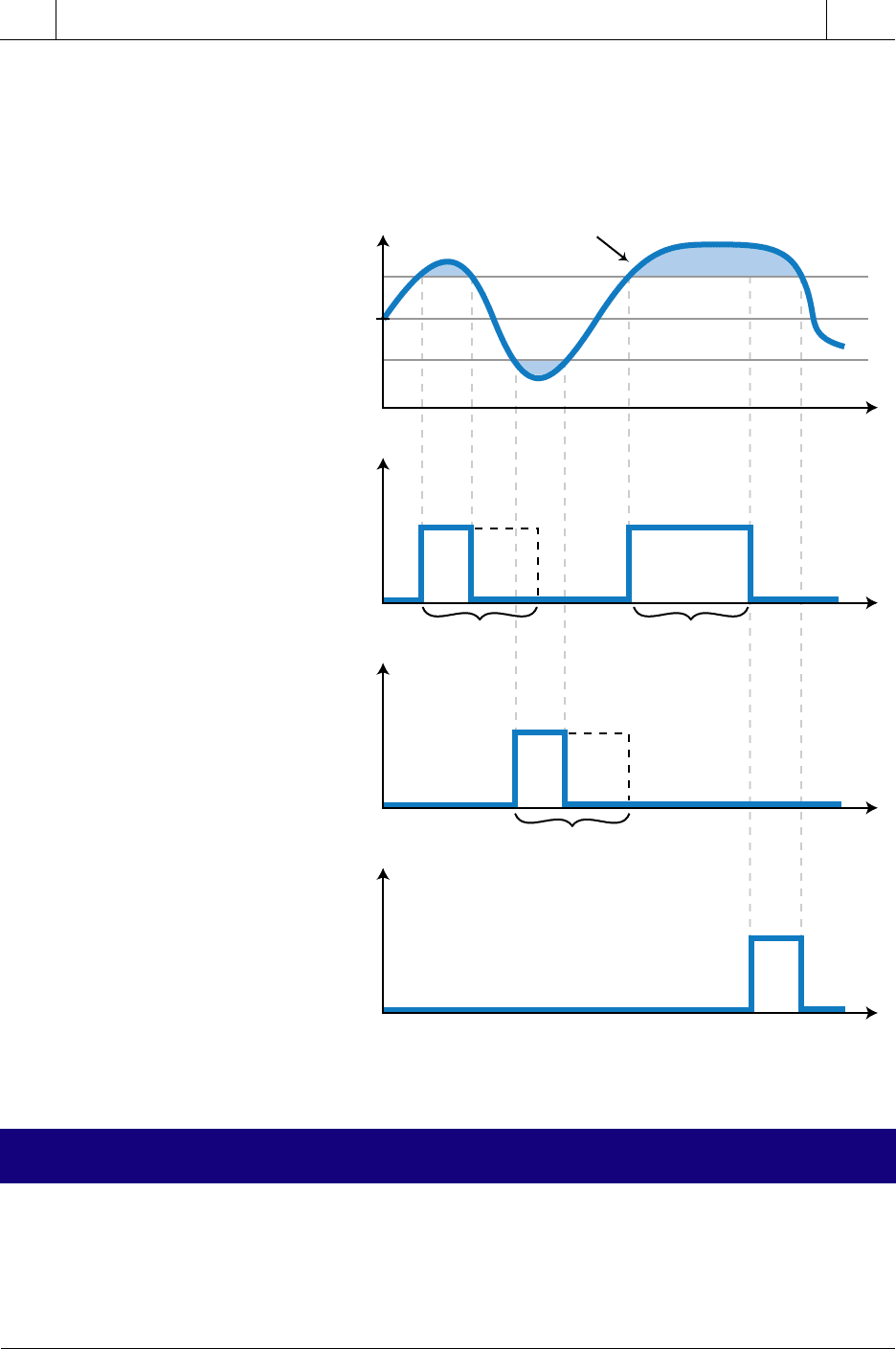
623
CHAPTER
14
Process Responses
and Transfer Functions
Industrial Text & Video Company 1-800-752-8398
www.industrialtext.com
SECTION
4
PLC Process
Applications
Figure 14-17. (a) Control loop process variable, (b) timer for upper limit alarm, (c) timer
for lower limit alarm, and (d) alarm activation.
SP – DB
SP
SP
+
DB
PV
t
Timer
PV
1
0
Required
Time
Timer
PV
<
(
SP – DB
)
1
0
Required
Time
Alarm
1
0
Required
Time
After required time, alarm
turns on until
PV
drops to
within deadband
PV
> (
SP + DB
)
(a)
(b)
(c)
(d)
in Figure 14-17, when the error condition exists for more than a specified
amount of time. Once the error exceeds the upper or lower limit, a timer starts
timing and triggers the alarm after it times out. The alarm indicator will
remain ON until the process variable returns to within the specified range.
14-3 PROCESS DYNAMICS
The term dynamics, as used in process control, refers to the changes that occur
in a process. These changes involve the response of the process system to
changes in its input (CV), which occur when disturbances are present, or to
changes in its set point (see Figure 14-18). Process dynamics does not refer
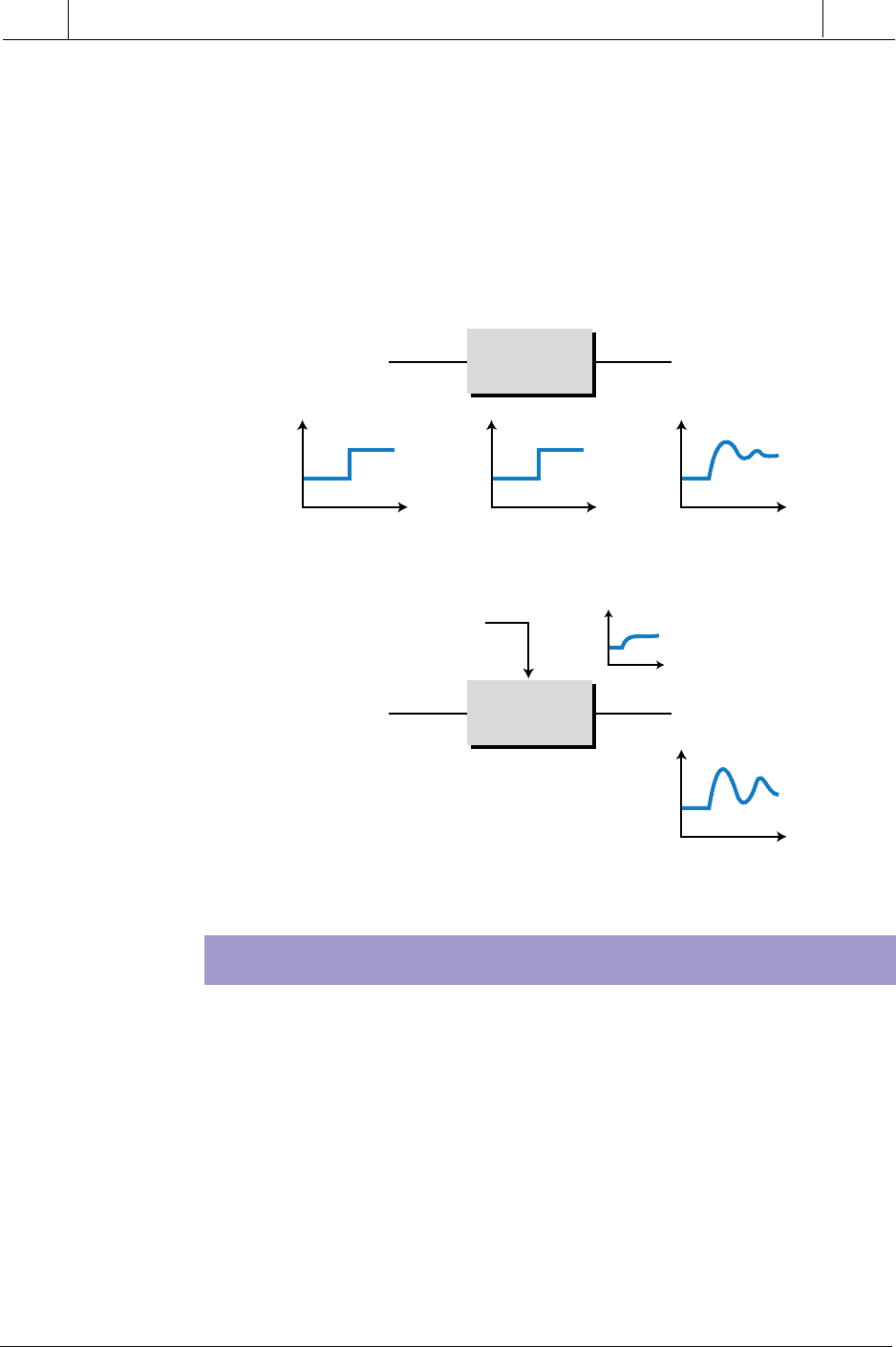
624
SECTION
4
PLC Process
Applications
Industrial Text & Video Company 1-800-752-8398
www.industrialtext.com
CHAPTER
14
Process Responses
and Transfer Functions
Figure 14-18. Process change due to (a) a change in set point and (b) a disturbance.
to the behavior of the process when the error is zero (or within the error
deadband). At this point, the process is said to be at steady state. Instead,
process dynamics deals with the system’s (process variable’s) reaction to
corrective actions taken by the controller to bring the error to zero after it
senses that the error is too large. Therefore, the analysis of process dynamics
explores the relationship between the control variable and the process
variable. This relationship is important during the “tuning,” or adjustment,
of system parameters, which we will discuss in the next chapter.
TRANSFER FUNCTIONS AND TRANSIENT RESPONSES
A process responds via the process variable (PV) to a change in input (CV) in
a dynamic manner according to the characteristics of the process. These
process characteristics, which include factors such as delay time and inherent
physical responses of the process, are defined by a transfer function,
represented by the term H
T
(see Figure 14-19). A transfer function is an
equation that describes a process in terms of response over time, as well as
calculates the outcome of the process variable. Therefore, the value of the
term H
T
equals the value of the process variable at a particular control
variable value and time, given the characteristics of the process. Every process
has its own unique transfer function based on its particular characteristics, and
for most processes, the transfer function equation is not known. Thus, certain
Process
PVCV
Input Output
SP
t
CV
t
PV
t
t
(a) Change in output due to a change in the set point
Process
PVCV
Input Output
Load
PV
t
(b) Change in output due to a disturbance
Disturbance
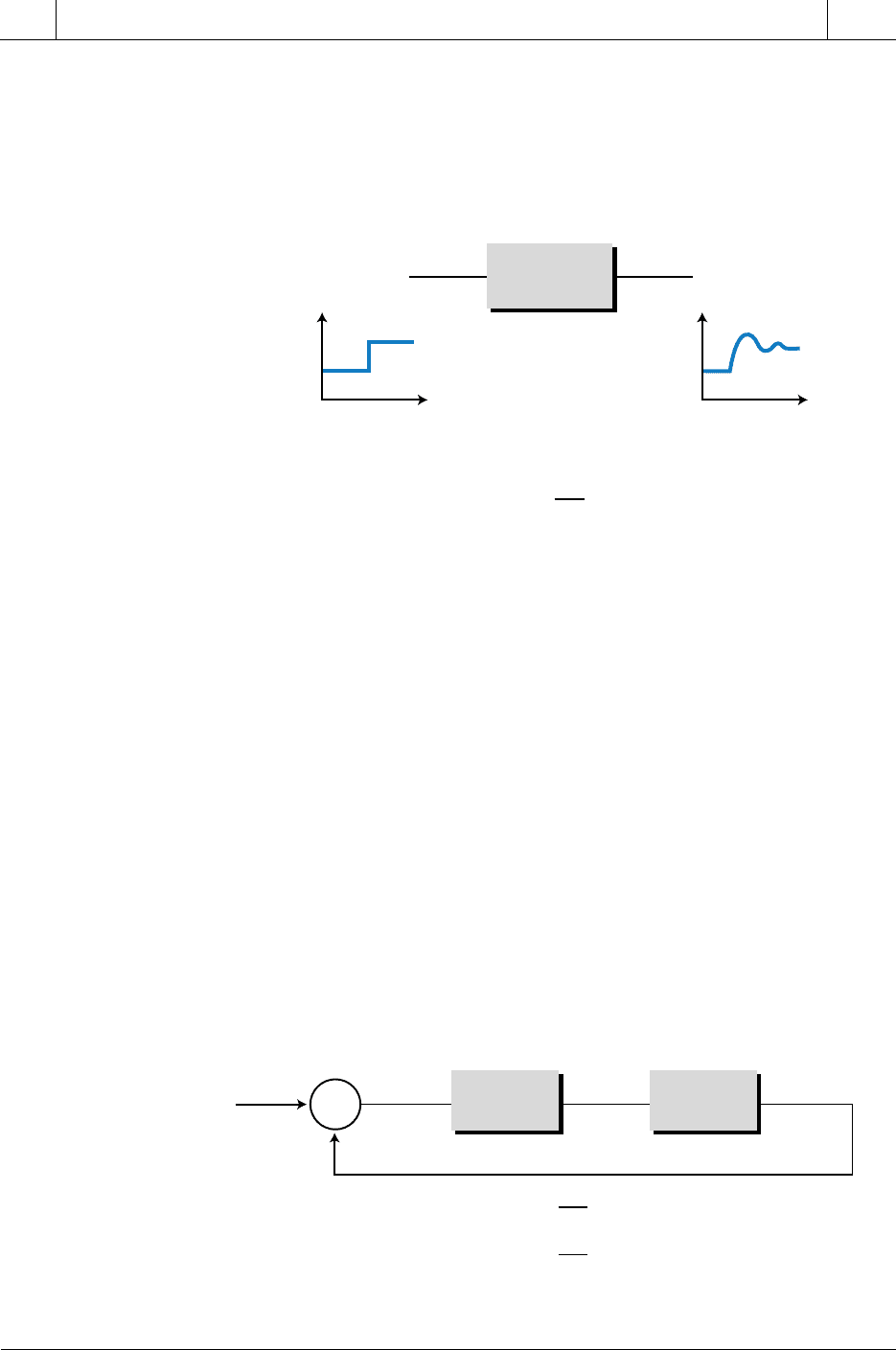
625
CHAPTER
14
Process Responses
and Transfer Functions
Industrial Text & Video Company 1-800-752-8398
www.industrialtext.com
SECTION
4
PLC Process
Applications
Figure 14-19. Transfer function.
Controller Process
ESP CV PV
PV
+
–
Σ
Hc
=
Hc Hp
CV
E
Hp
=
PV
CV
Figure 14-20. A closed-loop control system with two transfer functions.
Process
PVCV
CV
t
PV
t
H
T
H
T
=
Change in
CV…
through
H
T
…affects change in
PV
PV
CV
assumptions must be made about the process to estimate H
T
. Experimentation
can also be used to approximate the outcome of H
T
(i.e., the process variable
response) to a forced change in the process input. This experimental change
in process input is called a step test and the response is called a step response.
The most important aspect of a transfer function is not so much its composi-
tion or form, but its response to sudden process input changes created by
disturbances. This behavioral response of a process is called a transient
response, and it includes the time required for the output to reach a steady-
state final value given a sudden change in input. Transient responses provide
much information about the dynamics of a process and, therefore, about the
transfer function.
As shown in Figure 14-20, a closed-loop control system includes two transfer
functions—one that defines the controller (Hc) and another that defines the
process (Hp). The input to the controller’s transfer function is the error signal
(E), and its output is the control variable (CV). This control variable becomes
the input to the process’s transfer function, whose output is the process
variable (PV). In this chapter, we will discuss the process’s transfer function
and its behavior. In the next chapter, we will discuss the controller’s transfer
function and the different forms that it can take.
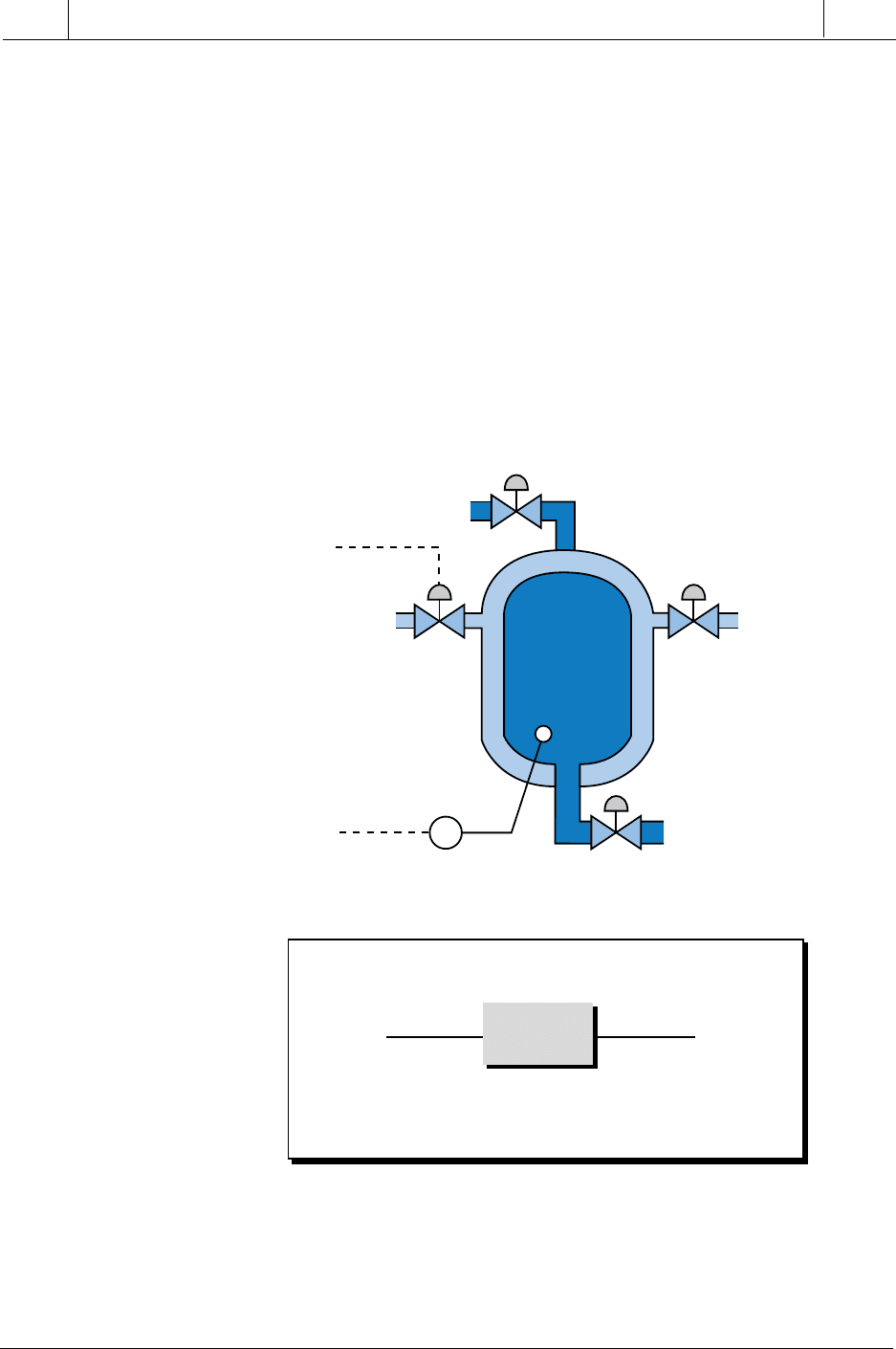
626
SECTION
4
PLC Process
Applications
Industrial Text & Video Company 1-800-752-8398
www.industrialtext.com
CHAPTER
14
Process Responses
and Transfer Functions
CV
PV
Steam
In
Steam
Return
Hot Water Out
Cold Water In
Temperature
Transmitter
TT
Figure 14-21. Hot-water heater system.
Figure 14-22. Water heater process diagram.
CV PV
Hp
Steam
Flow
Hot Water
Temperature
Hot-Water
Heater
Hp
is a function of steam flow, steam temperature, etc.
To better understand transient responses and the information we can obtain
from them, let’s explore a basic example of an open-loop hot-water heater
system. Figure 14-21 shows this process, while Figure 14-22 shows the
corresponding process block diagram. The transfer function of the process
depends on many factors, such as the rate of flow of the steam, the temperature
of the steam, the temperature of the incoming water at the inlet, the ambient
temperature, and the inflow and outflow rates of the water. Regardless of all
these process factors, the controller must maintain the temperature in the tank
(the process variable) as close as possible to the user-defined set point by
manipulating the control variable. For this example, let’s assume that the
temperature in the tank (at steady state) is at a set point of 65°C, the
temperature range spans from 15°C to 93°C, and the steam control valve is at
55% of its open position.
With a step change in valve position from 55% to 75% open, the temperature
(PV) in the tank will begin to heat up (see Figure 14-23). After 15 minutes, the
process variable will increase to 81°C. The process variable’s behavior during
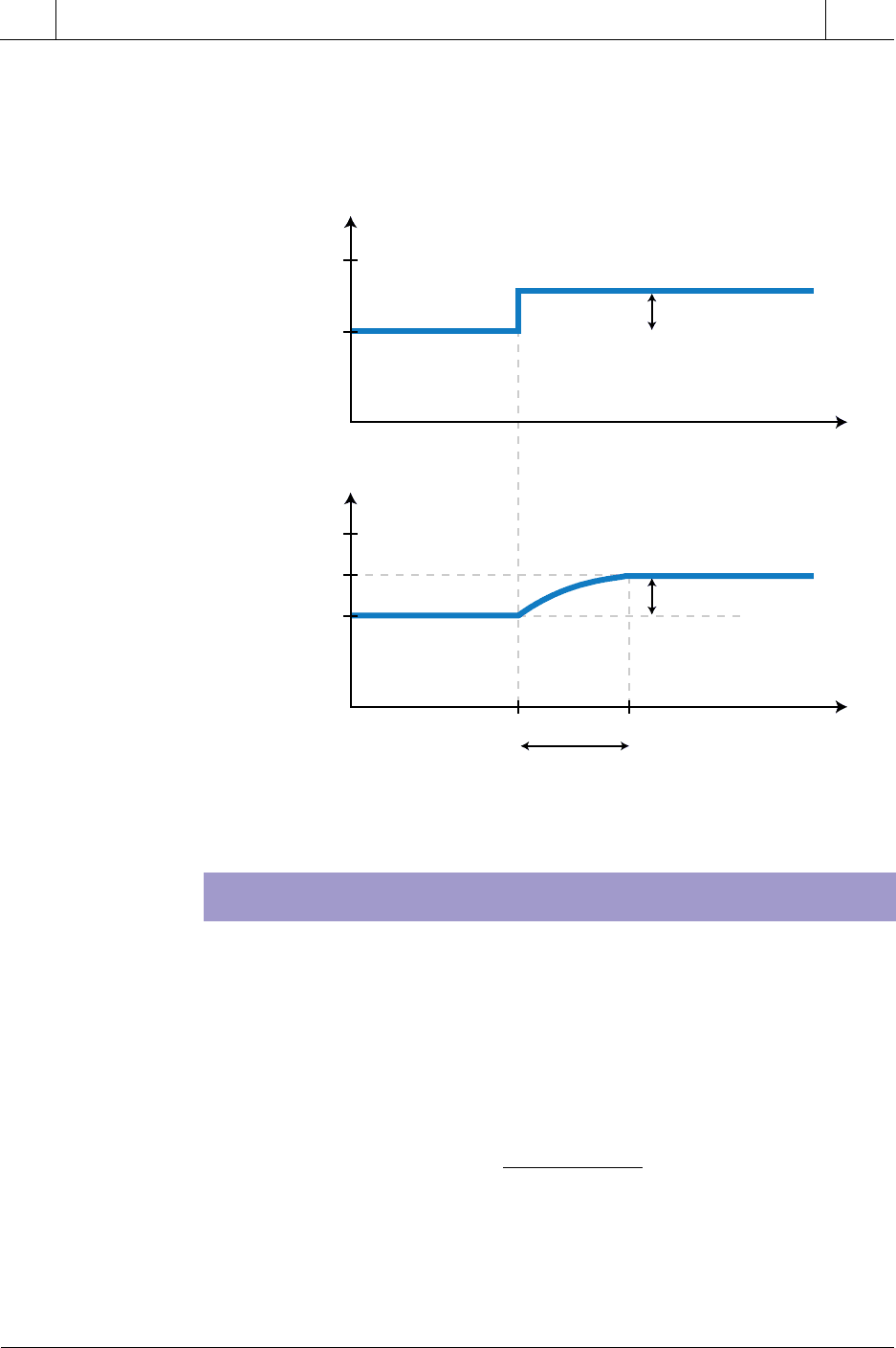
627
CHAPTER
14
Process Responses
and Transfer Functions
Industrial Text & Video Company 1-800-752-8398
www.industrialtext.com
SECTION
4
PLC Process
Applications
Figure 14-23. (a) Control variable step change and (b) its corresponding process
variable change.
0%
55%
100%
CV
t
75%
20% input change
15°C
65°C
93°C
PV
t
81°C
16°C input change
t
0
t
1
15 min
(a)
(b)
this 15-minute period is the transient response of the transfer function Hp.
Note that the transient response is very smooth, heating the water slowly over
the 15 minutes until steady state is once again achieved.
PROCESS GAIN
The process gain, represented by the term K, defines the ratio between
process output and process input. This gain is another dynamic element that
is observed in a transient response. It is calculated by dividing the change in
process output over a period of time by the corresponding change in process
input. Thus, the process gain is equal to the change in the process variable
divided by the change in the control variable:
K
PV PV
CV CV
=
−
−
final initial
final initial
Hence, for the previous hot-water tank example, K would be the change in the
tank temperature divided by the corresponding change in the valve output
over the 15-minute period:
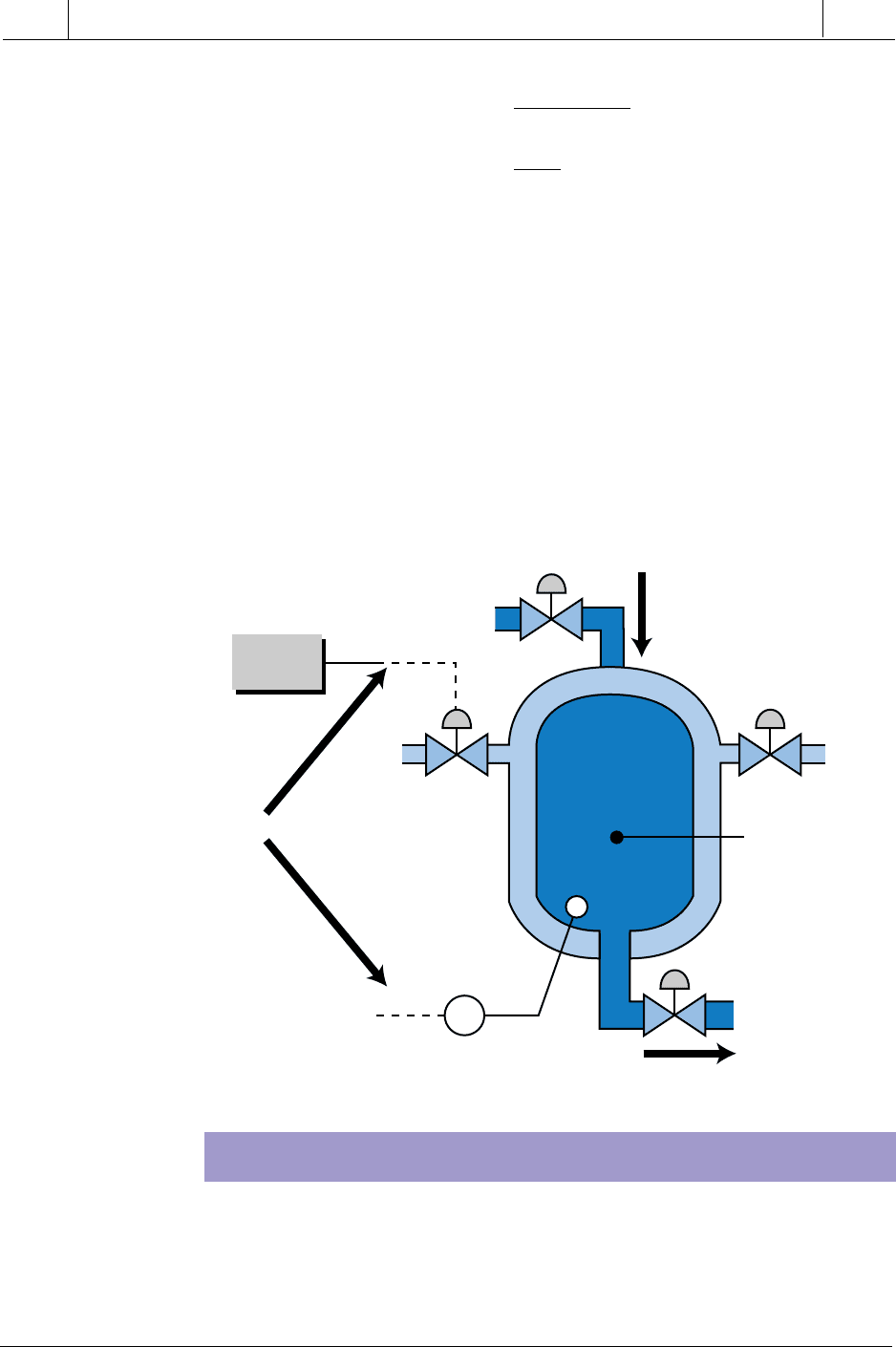
628
SECTION
4
PLC Process
Applications
Industrial Text & Video Company 1-800-752-8398
www.industrialtext.com
CHAPTER
14
Process Responses
and Transfer Functions
Figure 14-24. Process gain in the hot-water tank example.
CV
PV
Steam
In
Steam
Return
Constant Output
Flow (
Q
out
)
Cold Water In
Constant
Mass of Water
Constant
Input Flow (
Q
in
) and
Temperature (
Q
in(Temp)
)
Controller
From
To
Gain = 0.8°C/%
Hc
TT
K =
°− °
−
=
°
=°
81 C 65 C
75% 55%
C
C
16
20
08
%
./%
So, the process gain is 0.8°C/%. This means that the process variable
(temperature) changes 0.8°C for every one percent of change in the control
variable (steam valve). The process gain calculation of 0.8°C/% (see Figure
14-24) is only valid for the process conditions under which it was calculated
(i.e., a constant inflow and outflow of water—Q
in
and Q
out
, respectively—
at a constant water temperature). Under these conditions, the mass of water
in the heater tank remains constant and the steam heating system’s gain
(0.8°C/%) operates linearly over the span of the temperature range. If either
the input water flow Q
in
or any other parameter changes, the gain of the system
will also change.
DEAD TIME
The perfect response of a process variable to a step change in the control
variable is instantaneous, as shown in Figure 14-25. In this type of perfect
system, the process’s transfer function is equal to 1, meaning that a control
variable input immediately results in an equal process variable output. In
